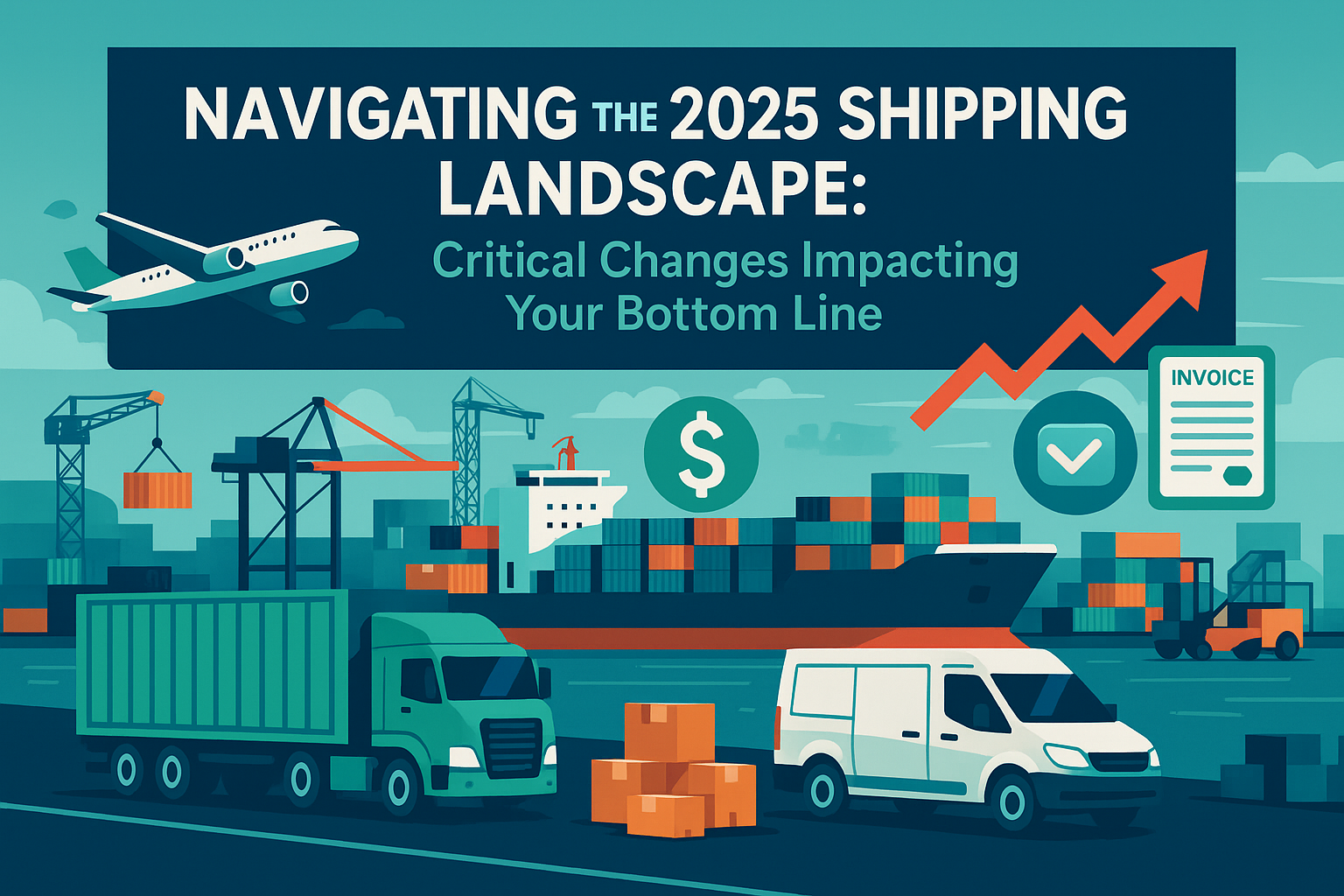Navigating the 2025 Shipping Landscape: Critical Changes Impacting Your Bottom Line
Staying ahead of carrier changes is crucial for maintaining cost-effective shipping operations. The first half of 2025 has already introduced significant shifts in pricing structures, surcharges, and policies from major carriers that will directly impact your logistics costs.
Recorded: June 12, 2025
Time: 1 pm PT / 4 pm ET

UPS Implements Sweeping Changes
UPS has rolled out numerous modifications that demand immediate attention from shippers across all industries:
Rate and Service Restructuring
In late December 2024, UPS announced substantial changes to their SurePost rates and ancillary charges, which have since been rebranded as "Ground Saver." These adjustments include:
- Zone 2, 1 lb. rates increased 9.8% to $12.28 before discounts
- Zone 2, less than 1 lb. rates increased 9.8% to $12.18 before discounts
- Delivery Area Surcharge (DAS) increased a staggering 61.8% to $6.15 per package before discounts
- DAS Extended Charges jumped 69.3% to $8.30 per package before discounts
More recently in May 2025, UPS Mail Innovations rates increased by approximately 40%, representing one of the most significant hikes in recent memory.
New and Increased Surcharges
UPS has implemented a series of new fees and surcharge adjustments:
- Fuel Surcharge Adjustments (March 10, 2025): A 50 basis point (0.50%) increase for U.S. Ground Domestic, Ground Saver (formerly SurePost), and U.S. Domestic Air services. These surcharges fluctuate with fuel prices and can substantially impact overall shipping costs.
- Paper Commercial Invoice Services Surcharge (March 17, 2025): A $10.00 fee per shipment when commercial invoices aren't provided digitally through UPS Paperless Invoice services.
- Scheduled Pickup Fuel Fees (March 24, 2025): The UPS Ground Domestic and Ground Saver Fuel Surcharge now applies to weekly scheduled pickup fees.
- Print Invoice Fee (March 31, 2025): A new $5.00 fee applies to every printed invoice copy sent to shippers or payers.
- Zone Updates (March 24, 2025): UPS updated shipping zones for certain origin/destination ZIP code pairs, though detailed guidance on these changes remains limited.
Payment Processing Changes
UPS has also revised their payment terms and added new processing fees:
- Payment Method Fees (March 31, 2025): Payments by check or wire transfer now incur a $25.00 fee per transaction (ACH payments remain exempt).
- Late Payment Penalties (March 31, 2025): Late payment fees increased from 8% to 9.9% of past-due balances, including prior late fees.
- Payment Processing Fee (May 19, 2025): A new 2% fee applies to most invoice charges on each invoice, not just shipping costs.
FedEx Responds with Competitive Adjustments
Not to be outdone, FedEx has implemented its own significant changes:
- Additional Handling – Dimensions: Without discounts or changes, the minimum billable weight is now 40 lbs., creating substantial challenges for e-commerce brands.
- Delivery Area Surcharges: Similar to UPS, FedEx increased their surcharges above the General Rate Increase (GRI) for DAS, DAS-Extended, and Remote locations.
- ZIP Code Reclassifications: More ZIP codes have been added to DAS/DAS-Extended categories, expanding the reach of these premium surcharges.
- International Fuel Surcharge Modifications: The FSC percentage increases dramatically as jet fuel prices fluctuate. For example, when jet fuel prices are between $2.31-$2.35 per gallon, export surcharges reach 24% while import surcharges climb to 27.75%. Without appropriate discounts, these fluctuations can lead to dramatic cost increases.
Cost Optimization Strategies for Forward-Thinking Shippers
These carrier changes underscore the importance of proactive cost optimization in supply chain management. Here are key strategies to consider:
- Conduct regular rate assessments: Review your shipping data to identify patterns and potential areas for cost reduction in your logistics operations.
- Leverage professional rate negotiation: Working with logistics consulting experts can help secure more favorable terms that align with your specific shipping profile.
- Diversify carrier options: Implementing a multi-carrier strategy through strategic parcel sourcing can provide flexibility and mitigate the impact of individual carrier changes.
- Optimize packaging: Minimizing dimensional weight charges through improved packaging strategies can yield significant savings.
- Audit invoices diligently: With the new surcharges and fees, regular auditing becomes essential to identify billing errors and opportunities for refunds.
Stay Informed with Our Upcoming Webinar
The complexities of these carrier changes require comprehensive understanding and strategic planning. To help you navigate these challenges and implement effective cost reduction strategies in logistics, we're hosting an exclusive webinar: "Mastering the 2025 Carrier Landscape: Strategies for Sustainable Savings" on June 12, 2025 at 1 pm PT / 4 pm ET.
During this session, our team of logistics cost savings experts will provide:
- Detailed analysis of recent carrier changes
- Actionable strategies for cost optimization in supply chain operations
- Case studies highlighting successful rate negotiation outcomes
- Q&A opportunities with our experienced consultants
As the logistics landscape continues to evolve, staying informed and working with experienced partners becomes increasingly valuable. At Trans-Solutions, we remain committed to providing the insights and expertise you need to maintain a competitive and cost-effective shipping operation.
Paul Brinkman is the President of Trans-Solutions, a leading provider of logistics consulting services specializing in cost reduction in supply chain management, parcel sourcing, and rate negotiation. With over two decades of industry experience, Trans-Solutions helps businesses optimize their logistics operations and achieve sustainable cost savings.
